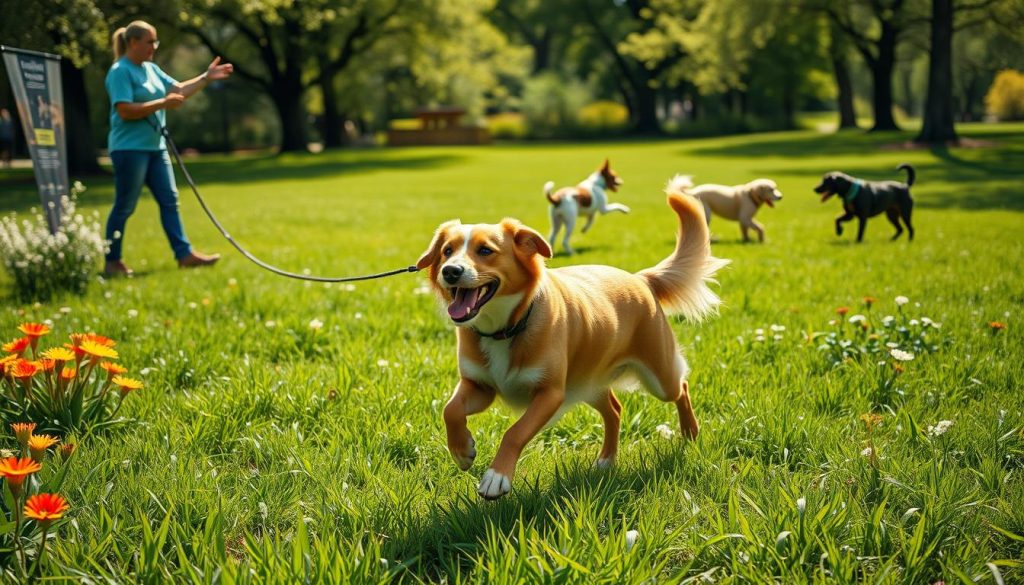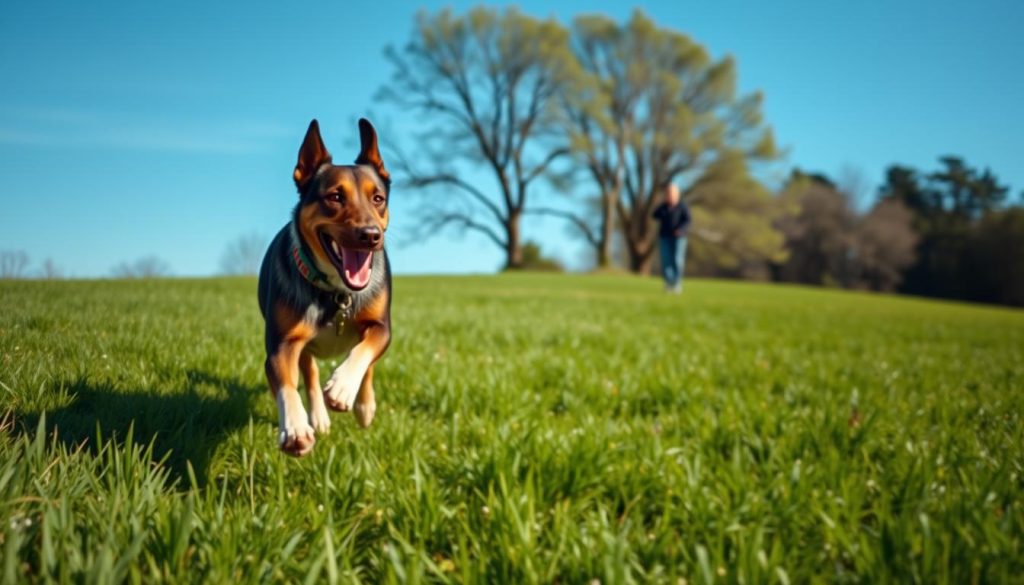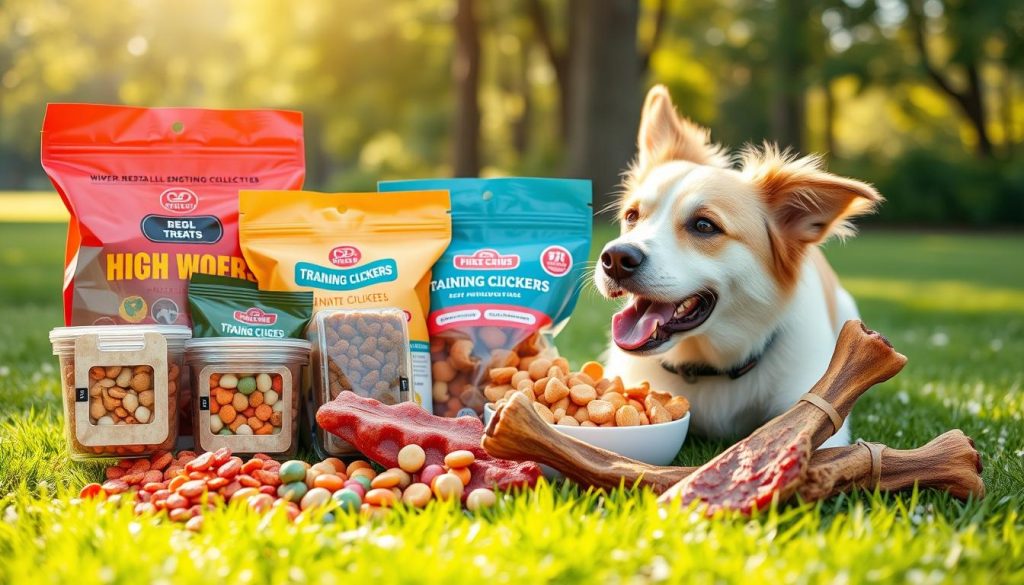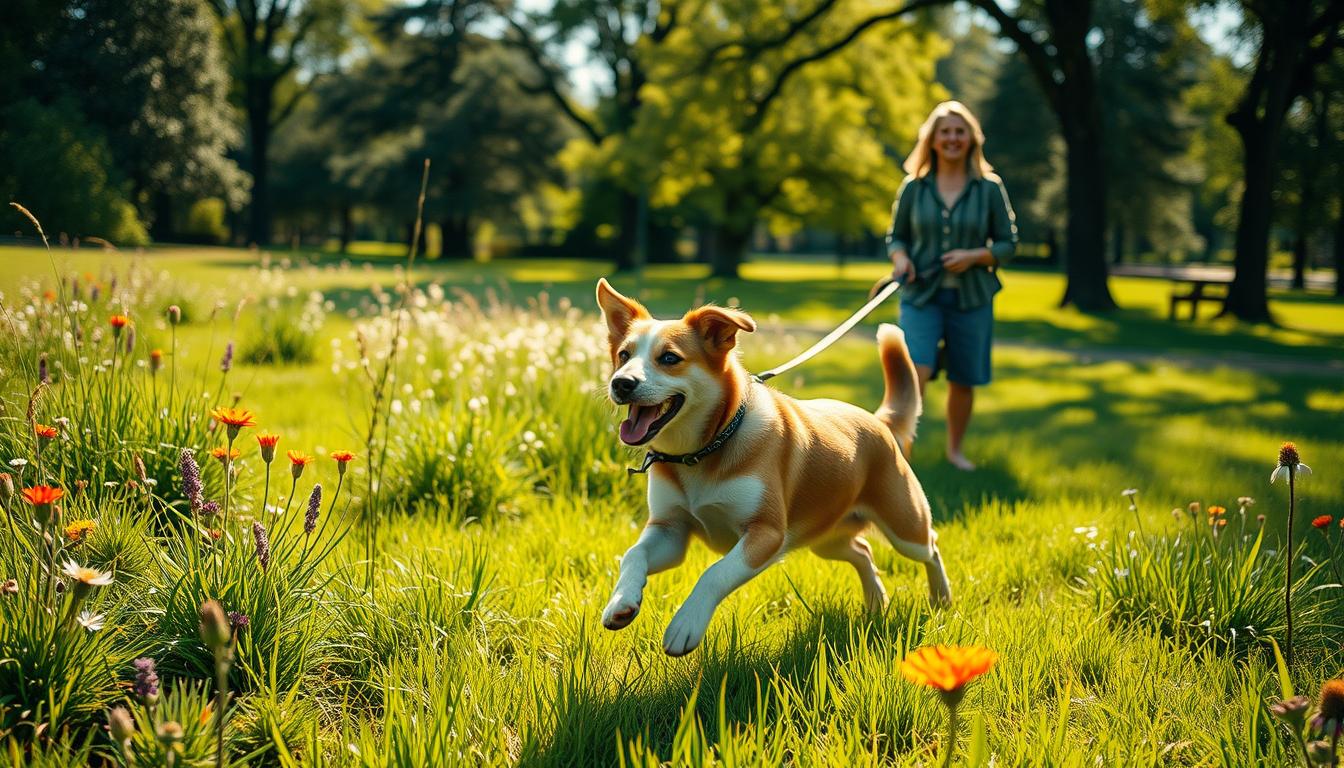As a passionate pet owner, I know the joy of walking my dog off-leash. But, it takes dedicated training and effort. In this guide, I’ll share expert tips and proven techniques for dog off-leash training. This will help you enjoy off-leash walks and improve your dog’s recall.
This guide covers key topics like the importance of off-leash training and building trust. We’ll also talk about enhancing your dog’s confidence and mastering the recall command. You’ll learn a step-by-step process for off-leash dog training. This includes creating a secure environment and introducing distractions.
By the end of this article, you’ll have the tools and techniques to train dogs to be off-leash. You’ll enjoy the benefits of off-leash obedience training with your furry friend.
The Importance of Off-Leash Training
Starting off-leash training with your dog is a big step. It changes your bond and your dog’s life for the better. This training opens up new adventures and strengthens your trust.
Building a Solid Foundation of Trust
Trust is key in off-leash training. It comes from positive feedback, clear signals, and patience. Your dog will feel safe and want to follow you.
Enhancing Your Dog’s Confidence
Off-leash training boosts your dog’s confidence too. It lets them explore and make choices in a safe space. A confident dog is happier and more obedient.
The importance of off-leash training, the benefits of off-leash training, the building trust for off-leash training, and the boosting dog confidence for off-leash are all crucial. They make off-leash adventures safe and fun for you and your dog. With effort and the right approach, you’ll enjoy more freedom and a closer bond with your dog.

Mastering the Recall Command
Mastering the recall command is key for off-leash training. It keeps your dog safe and lets you enjoy activities without worry. Training your dog to come when called, even with distractions, builds your confidence.
To master the recall command for off-leash training, start with trust. Use treats and praise to make the recall rewarding. Practice in a quiet area, then add more challenges as your dog gets better.
Consistency is crucial for training dog recall for off-leash. Always use the same command and reward your dog right away. With patience, your dog will come to you quickly, even with distractions.
Improving dog recall is a continuous effort. Practice often and adjust your training as needed. Mastering the recall opens up a world of freedom and fun for you and your dog.

Dog off-leash training: A Step-by-Step Guide
Off-leash training is a journey that needs a clear plan. As a pet owner, I’ll show you how to start with a safe off-leash training environment. Then, we’ll add distractions in off-leash training to make your dog reliable and focused, even when there’s temptation around.
Starting with a Secure Environment
The first step is to make a safe space for your dog. This could be a fenced yard, a park with off-leash areas, or any place where your dog can run free without danger.
Introducing Distractions Gradually
After your dog feels safe and confident, it’s time to add distractions. Start with family members, friends, toys, other animals, or sounds. Slowly increase these distractions to teach your dog to stay focused and listen to you, even when things get interesting.
| Step | Description |
|---|---|
| 1. Secure Environment | Create a safe, enclosed area for off-leash training. |
| 2. Introduce Distractions | Gradually expose your dog to various stimuli while training. |
| 3. Reinforce Positive Behavior | Use rewards to encourage your dog’s focus and responsiveness. |
| 4. Expand Training Area | Gradually increase the size of the training environment. |
Positive Reinforcement Techniques
Positive reinforcement is key for off-leash training success. It uses your dog’s natural likes to shape their behavior. This makes training fun for both you and your dog.
Using High-Value Rewards
High-value rewards are the secret to off-leash training. These are treats, toys, or activities your dog loves. They make your dog want to repeat the desired behaviors.
Using these rewards during recall is very effective. When your dog comes back, give them a treat or play fetch. This makes recall a positive experience your dog will want to repeat.
It’s important to know what your dog likes best. What one dog finds irresistible, another might not. Try different rewards to find what really excites your dog.

Positive reinforcement, especially with high-value rewards, builds trust and confidence. It makes training fun and ensures your dog follows commands even with distractions.
Reading Your Dog’s Body Language
Learning to read your dog’s body language is key for off-leash training success. I’ll help you improve your observation skills. You’ll learn to spot the signs that show your dog’s mood and readiness to follow commands off-leash.
Watching your dog’s body language helps you understand their feelings. This lets you adjust your training to meet their needs. Here are important body language signs to look for:
- Relaxed, open posture: Your dog is calm and ready to learn.
- Ears forward and alert: Your dog is focused and interested.
- Wagging tail: A relaxed tail wag means they’re in a good mood.
- Panting with a relaxed tongue: They’re calm and not stressed.
- Lowered head and body: They might be feeling anxious or shy.
- Stiff, tense body: They could be feeling scared or uncomfortable.
- Growling or barking: They’re showing discomfort or wanting to protect themselves.
By watching your dog’s body language during off-leash training, you can make better choices. You’ll know when to offer more support or introduce new challenges. This ensures your dog’s safety and training success.
Understanding your dog’s body language is a skill that improves your off-leash training. It also strengthens your bond with your dog. Pay attention to their subtle signals, and you’ll be on the path to off-leash success.
Creating a Safe Off-Leash Experience
Keeping you and your dog safe is key when training off-leash. Picking the right places is vital for a fun and safe time for your dog. Let’s look at what to consider when choosing where to go off-leash.
Choosing Appropriate Locations
When looking for off-leash spots, remember a few things:
- Secured and Enclosed Spaces: Go for fenced areas, dog parks, or other safe spots where your dog can play without danger.
- Low-Distraction Environments: Pick places with few distractions, like crowds or loud noises, to help your dog listen to you better.
- Familiar Surroundings: If you can, choose places your dog knows well. This makes them more comfortable and easier to train.
- Appropriate Terrain: Make sure the ground is right for your dog, whether it’s grass, sand, or trails.
- Accessibility and Supervision: Choose spots where you can watch your dog closely and step in if needed.
By picking the right off-leash spots, you can make sure both you and your dog have a great time. Your dog gets to run and play, and you can relax knowing they’re safe.
Troubleshooting Common Challenges
Even the most well-trained dogs can sometimes face challenges during off-leash training. As an experienced dog trainer, I’m here to help. I’ll give you practical solutions to common issues and help you overcome any obstacles.
Managing distractions is a common problem. If your dog gets easily distracted by squirrels or other animals, it can be tough. To solve this, use high-value treats and gradually increase distractions during training. This will help your dog stay focused and responsive, even when tempted.
Improving recall is another challenge. If your dog ignores your calls or is hesitant to return, use enthusiastic praise and treats. Practice in different places to make sure your dog comes back reliably. This keeps them safe and you worry-free during off-leash walks.

